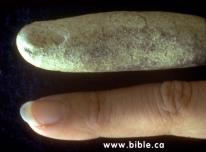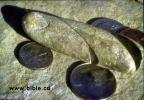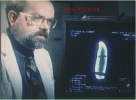Fossilized Human Finger: Interesting
Fossilized Human Finger:
Found in a formation famous for its dinosaurs, supposed to be 110 million years old (Middle Cretaceous).

|
|
Some argued that it could not be a fossilized finger since pressure from overlying layers mashes fossils flat. This is usually true, but not in the Glen Rose Formation. Several locations reveal thousands of fossilized worms that are perfectly three dimensional. If anything should be mashed flat it would be worms, but they are not. Obviously, very rapid lithification is required in order to preserve such astonishing detail. | |
|
|
Some who claim to be scientists will immediately say, "It's just a rock." They "know" humans did not live with dinosaurs, so it can't be a fossil finger, no matter how much it looks like a finger. Science proceeds in a different manner. Real scientists perform experiments that will test their conclusions. We sectioned this fossil to see if any indication of interior structure was preserved which would allow us to determine whether this was a fossil finger or a strange looking rock. | |
|
|
The fossil has been replaced with limestone. Sometimes replaced fossils maintain their interior structure. Sometimes they do not. Fortunately, when the fossil was sectioned, we were able to see obvious indications of bone and ligaments. | |
|
|
Medical Doctor Dale Peterson of Oklahoma City, OK examined the sectioned specimen by means of x-ray, CT Scan and MRI. He was able to identify joints and to trace tendons throughout the length of the fossil. His expert conclusion is: "There can be no reasonable doubt that this is a fossil finger." | |
Dale H. Peterson, M.D. 1050 E. 2nd, # 242 March 27, 2002 Dennis Petersen
Dear Dennis, I was first able to view what I now believe to be a fossilized human finger shortly after it was excavated. At that time my comment was "interesting". The fossil clearly had the shape of a human finger. It had a fine taper of the tip, typical of a female finger. Male fingers tend to be a bit more blunt. The fingernail and cuticle were clearly visible and perfectly formed and proportioned. Nevertheless, I withheld judgment as to its authenticity knowing that rocks such as limestone can assume nearly any shape when they flow into a hole before setting up. Several years later I was privileged to view the fossil again after it had been sectioned. At that time I observed that the fossil was not of uniform or random density and coloration. The internal appearance of the fossil was identical to what one sees when a human finger is sectioned. The skin margins and subcutaneous tissue were clearly delineated. The bone matrix was clearly defined, and features consistent with flexor and extensor tendons were present. CT scans of the fossil likewise revealed the anatomical features of a human finger, as noted above. It is my professional opinion that the fossil unearthed at Glen Rose, Texas, is, in fact, a petrified human finger and not an infill of a wormhole or similar artifact. Sincerely, Dale H. Peterson, M.D. | |





0 Comments:
Post a Comment
<< Home